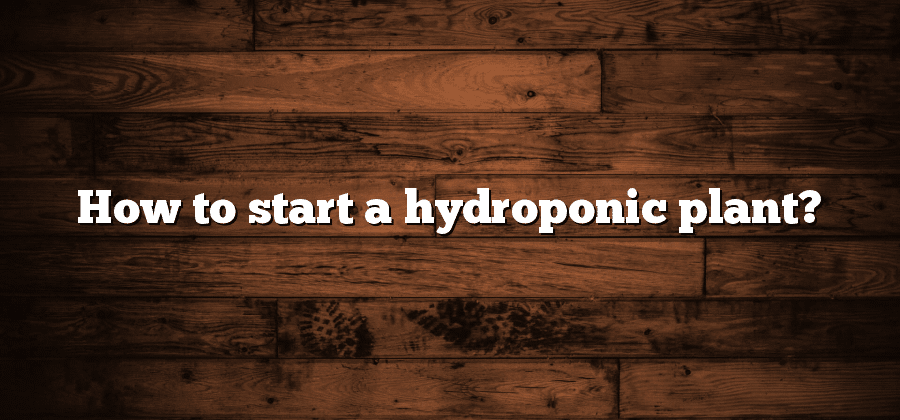Getting Started with Hydroponic Plants
Hydroponic gardening is gaining popularity among both experienced gardeners and avid plant enthusiasts. This innovative method of growing plants allows for a controlled environment where plants can thrive without the need for soil. One of the first steps to getting started with hydroponic plants is to choose the right system. There are various options available, such as nutrient film technique (NFT), deep water culture (DWC), and drip systems, each with its own advantages and disadvantages. It is important to consider factors such as space availability, budget, and personal preferences when selecting the ideal hydroponic system.
Once the hydroponic system has been chosen, the next step is to select an appropriate growing medium. Unlike traditional gardening, where plants rely on soil for nutrients and support, hydroponic plants need a medium that can hold the roots in place while allowing them access to water and nutrients. Commonly used mediums include perlite, coconut coir, rockwool, and expanded clay pellets. Each medium has its own characteristics, and selecting the right one depends on the type of plants being grown and the specific needs of the hydroponic system. By providing the plants with an ideal growing medium, their roots can flourish and absorb the necessary nutrients, leading to healthy and robust growth.
Choosing the Right Hydroponic System
Hydroponic systems have revolutionized the way we cultivate and grow plants indoors. With a wide variety of systems available in the market, it can be overwhelming to choose the right one for your specific needs. However, with proper research and understanding, you can select the ideal hydroponic system that will ensure successful plant growth and maximum yields.
One of the most common types of hydroponic systems is the nutrient film technique (NFT) system. This system involves a continuous flow of nutrient-rich water that flows over the roots of the plants, providing them with the necessary nutrients and oxygen. It is a highly efficient system that requires minimal water and nutrient usage, making it a popular choice for many growers. Another popular choice is the ebb and flow system, also known as the flood and drain system. This system works by periodically flooding the growing medium with nutrient-rich water and then allowing it to drain away. It is a versatile system that can be used with various growing mediums and is suitable for a wide range of plant species.
When selecting a hydroponic system, it is important to consider factors such as the size of your growing space, the type and number of plants you wish to grow, and your level of experience. Additionally, you should also consider the maintenance requirements and the cost of setting up and operating the system. By carefully evaluating these factors and understanding the specific needs of your plants, you can make an informed decision and choose the right hydroponic system that will support healthy plant growth and ensure a successful harvest.
Selecting the Ideal Growing Medium
One of the key factors to consider when setting up a hydroponic system is selecting the ideal growing medium. The growing medium plays a critical role in providing support, nutrients, and moisture to the plants’ roots. It is important to choose a medium that is suitable for hydroponic cultivation and promotes healthy root development.
There are several types of growing mediums commonly used in hydroponics, each with its own advantages and considerations. Inert mediums such as perlite, vermiculite, and rockwool are popular choices as they are lightweight, sterile, and provide excellent aeration to the roots. Other organic mediums like coconut coir and peat moss offer good water retention capabilities and can be easily mixed with other ingredients to create a customized blend. It is essential to consider factors such as the pH level, water retention capacity, and availability when choosing the right growing medium for your hydroponic system.
Picking the Perfect Hydroponic Plants
When it comes to picking the perfect hydroponic plants for your system, there are several factors to consider. First and foremost, you need to evaluate the space you have available and the specific requirements of each plant. Consider the height, width, and root structure of the plants, as well as their light and nutrient needs.
Another important consideration is the time and effort you are willing to invest in maintaining your hydroponic garden. Some plants require more attention and care than others, so it’s crucial to choose varieties that align with your level of commitment. Additionally, think about your end goal. Are you looking for herbs and leafy greens for culinary purposes, or do you want to grow flowering plants for aesthetic appeal? Understanding your objectives will help guide your plant selection process.
Providing Adequate Lighting for Growth
When it comes to hydroponic plants, providing adequate lighting for growth is crucial. As these plants are not receiving natural sunlight, it is essential to replicate the necessary light conditions they require to thrive.
One option for providing lighting in a hydroponic system is using high-intensity discharge (HID) lights. These lights emit a strong and consistent light source, which encourages healthy plant growth. Another popular option is LED lights, which have become increasingly popular due to their efficiency and long lifespan. Whichever option you choose, ensure that the lighting is positioned correctly and that the intensity and duration of the light are adjusted according to the specific needs of your hydroponic plants. Providing the right amount of light can significantly impact the overall success and yield of your hydroponic garden.






